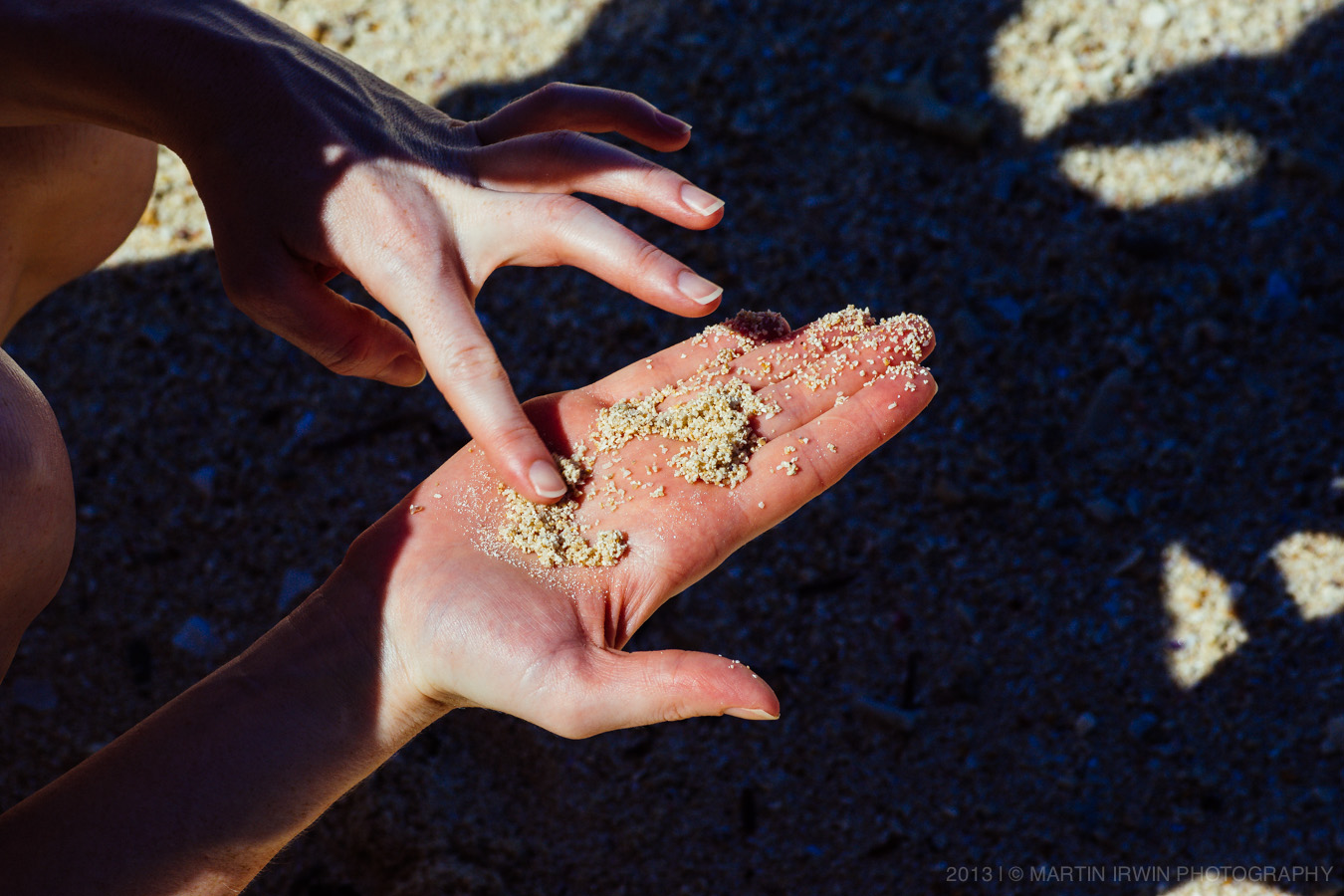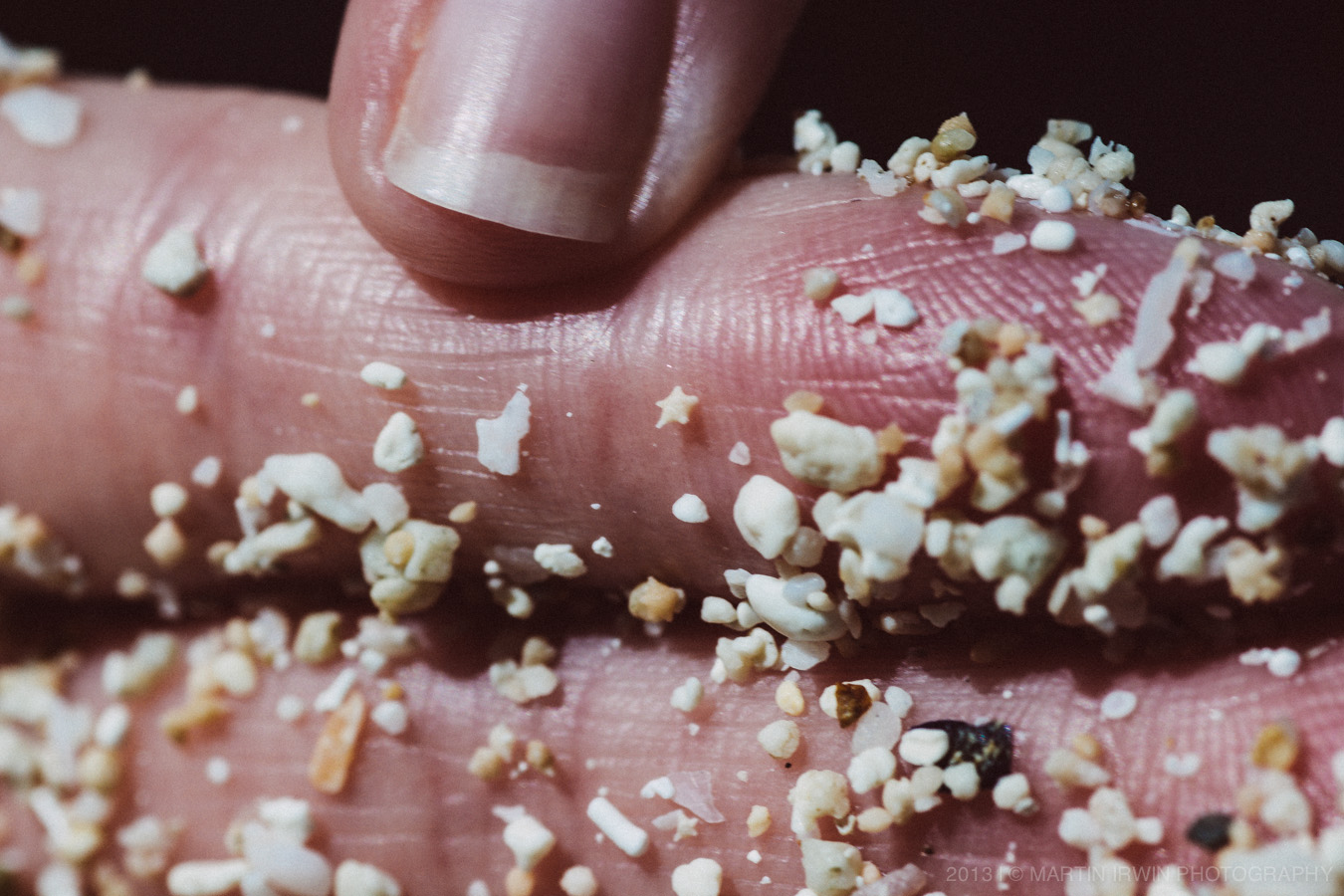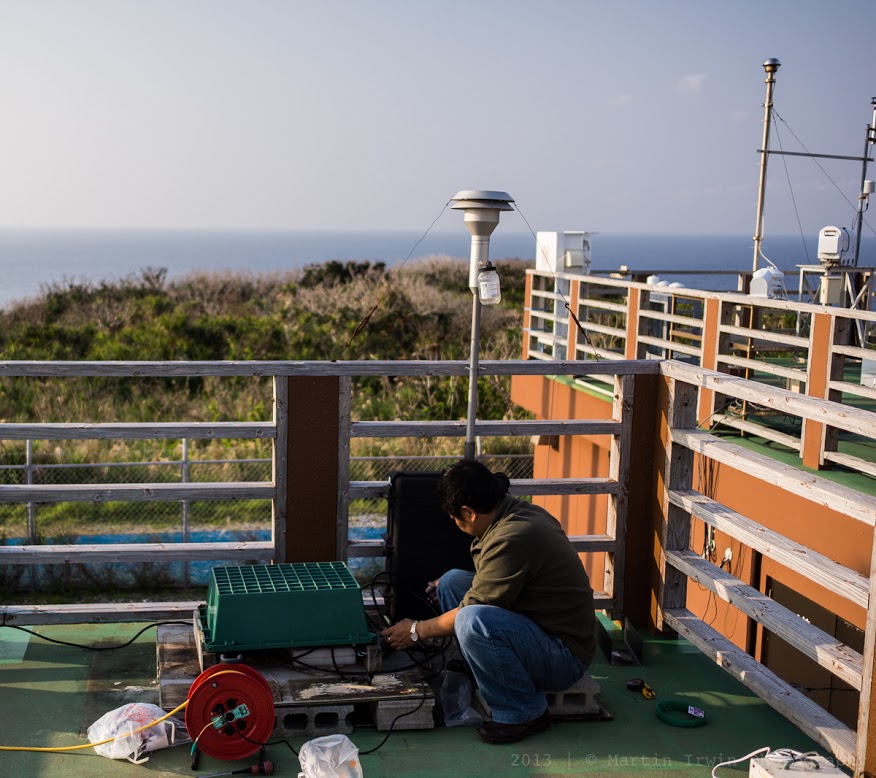Providing photographers with a way to take photos that renders camera usage transparent, is surely the ultimate goal of any camera manufacturer? No? Well it damn well should be.
Read Moreryukyu
Ishigaki Port & Kuroshima
We killed some time in Ishigaki city whilst waiting for a ferry to nearby Kuroshima.
Read MoreTake me To Taketomi
Sometimes a place sticks in your mind so much, that you have to go back. Sometimes, a place is so relaxing, that you need to return. For us, this place was the island of Taketomi in Okinawa prefecture.
Read MoreIshigaki Island – 石垣島
Though I've been fortunate enough to visit Okinawa numerous times, I've spent most of that time on the main island; Okinawa Honto. To see what else the prefecture has to offer, we decided to stay on nearby Ishigaki-jima.
Read MoreTaketomi is known for its traditional Ryukyuan houses, stone walls, and sandy streets. Photo taken just after sunset.
Taketomi-jima - 竹富島
Sometimes the stars align in such a way, that one is convinced of fate. Staying on Taketomi-jima (jima means island in Japanese), was one of those moments. We've looked into visiting here long ago, but ruled it out when we decided to keep the budget low and just visit Okinawa's main island. The problem is, that on the main island, a hire car is pretty much a necessity. This means that it worked out cheaper to use ANA airmiles for a flight to nearby Ishigaki (more on that island later), and a 15 minute ferry trip to Taketomi - an island like no other in Japan (or the world, for that matter).
If it weren't for the subtropical weather, and brilliant light, this could have been somewhere in the UK...
The drystone walls in Taketomi are just over 150cm high, so I have no trouble snooping around. The island is a raised coral atoll, which explains its extremely flat topography.
The plan here was simple. Sit in the sun and read, dip in a pool, drink beer, disconnect from the internet and all of the daily noise we're used to, and reset ourselves.
A modest, but essentially perfect dip-pool
Our plan worked. I've been much further from home, wherever that may be, but rarely have I felt so separate from the goings on of the world. Each day was taken as it came; there was little-to-no planning.
There's a beach famous for its star-shaped sand (which is actually not sand, but crustaceans). Apparently it brings good luck to those who find it!
It's when travelling around Japan, outside of my daily routine, that I'm often surprised at how surprised the local people are that I can speak Japanese. I take it for granted - there are numerous expats in Tokyo speaking the lingo. Come out here though, and usually the only tourists will be asian (mostly Japanese, then Chinese, then Korean). If there are any Westerners, they usually don't speak Japanese.
I'm not saying that it's easy to understand the Japanese terms for fruit you've never seen before...
No picture gives justice to the fresh mango juice
竹富そば - Taketomi soba
Well, this posting turned into another long one, loaded with photos! I'll end with two more. Each night, we went to the beach (the island is only around 3km wide) and watched the sun set. It does so very quickly this close to the equator. The sun would set over the nearby Iriomote island (西表島) which we visited in 2011.
Sunset over Iriomote island (西表島)
It was after sundown, in the pitch black, that we heard a group of Japanese tourists scream. They'd found a hermit crab, crossing the road... hardly worth a scream, you say? Well, this particular crab was at least 10cm across, and about 20cm long...
EDIT: I think this is Coenobita brevimanus, オオナキオカヤドカリ. For scale, look at the ground (sand).
As I was trying to take photos of stars at the time, and had drunk quite a few beers, I completely messed up this photograph. For those interested, the EXIF data is: 13s f/22.0 ISO1000 35mm. Illuminated by a flash of a torch, I turned the camera away after I'd realised the shutter hadn't closed. Then I held the camera in disbelieve. I entered the settings... and then the battery died! Yes, I possibly exclaimed at this point. OK, I did (sorry Charlotte!). The crab was then long gone, into the vegetation. The moment had gone. It was only when I got back to our house that I was blown away. Somehow, I had a useable photo! Huzzah!
I should count my lucky stars...
Note to self: never, ever, ever, under any circumstance, go out drinking and forget to bring your spare RX1 battery.
Okinawa Honto - 沖縄本島
I've been to Okinawa Honto (main island) around 7 times now, and manage discover something new and interesting with each visit. My last visit to Okinawa was in March of this year, but as I was there on a tight work schedule I didn't have time for sightseeing. In 2011 we both went to Okinawa for our first summer holiday since leaving Europe, and we had an amazing time. Last year, we had a blast in Thailand, but this year we decided to explore a little more of Okinawa whilst it's so close, as it's rather difficult to access from Europe.
Cape Maeda is a diving & snorkelling hot-spot
We planned to spend the entirety of our holiday on the main island, as there is still much to explore, and resorts in the more secluded islands can be rather expensive. Thanks to my friend Sho, we managed to rent a hire-car for around 30% of the price quoted directly from Nissan, which freed up a big part of the budget.
Our first port of call was Cape Maeda, around 1 hour's drive from the main city of Naha. We had 5 nights booked at a cute little guesthouse called Akachichi (the red roof in the opening photo is the traditionally-stylised roof of the guesthouse). The owners, Kenny and Komaki, really made us feel at home within around 5 minutes of our arrival, which meant we could start winding down and get into the holiday mood more easily. Though still Japan, life in Okinawa is very different to that on the mainland, especially that in Tokyo. In Tokyo, everything runs to the minute, without delay. In Okinawa, I don't usually wear a watch. The history of the islands is far too extensive to cover in a single post, but I'll point you in the direction of Okinawa Explorer (written by Kenny). Komaki also has a blog, where she writes about daily live in the area (mostly in Japanese, but with lots of photos).
We were asked what time we wanted breakfast, and and asked for a rather leisurely (especially by Japanese standards) 9am start. Though stereotypes and generalisations can often be wrong or insulting to some people, they must have originated somehow. Here's one for you - many Japanese love to pack their holiday full of more activities than my normal working week, waking up at sunrise, disappearing on tours or hikes, and returning after dark. We planned on lying on the beach, reading a book, and maybe going for a drive to find somewhere for dinner.
"Breakfast at 9, no problem!"
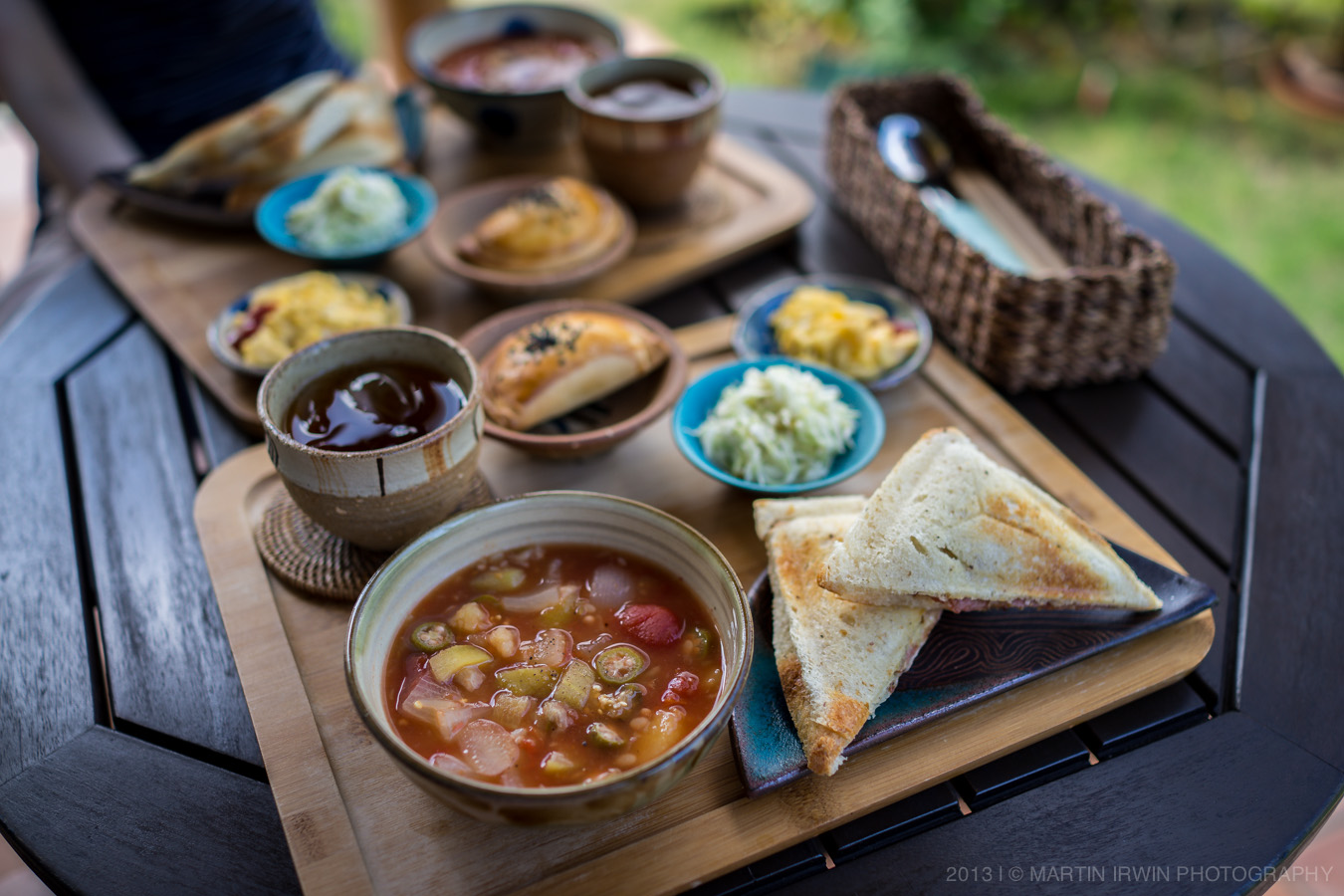
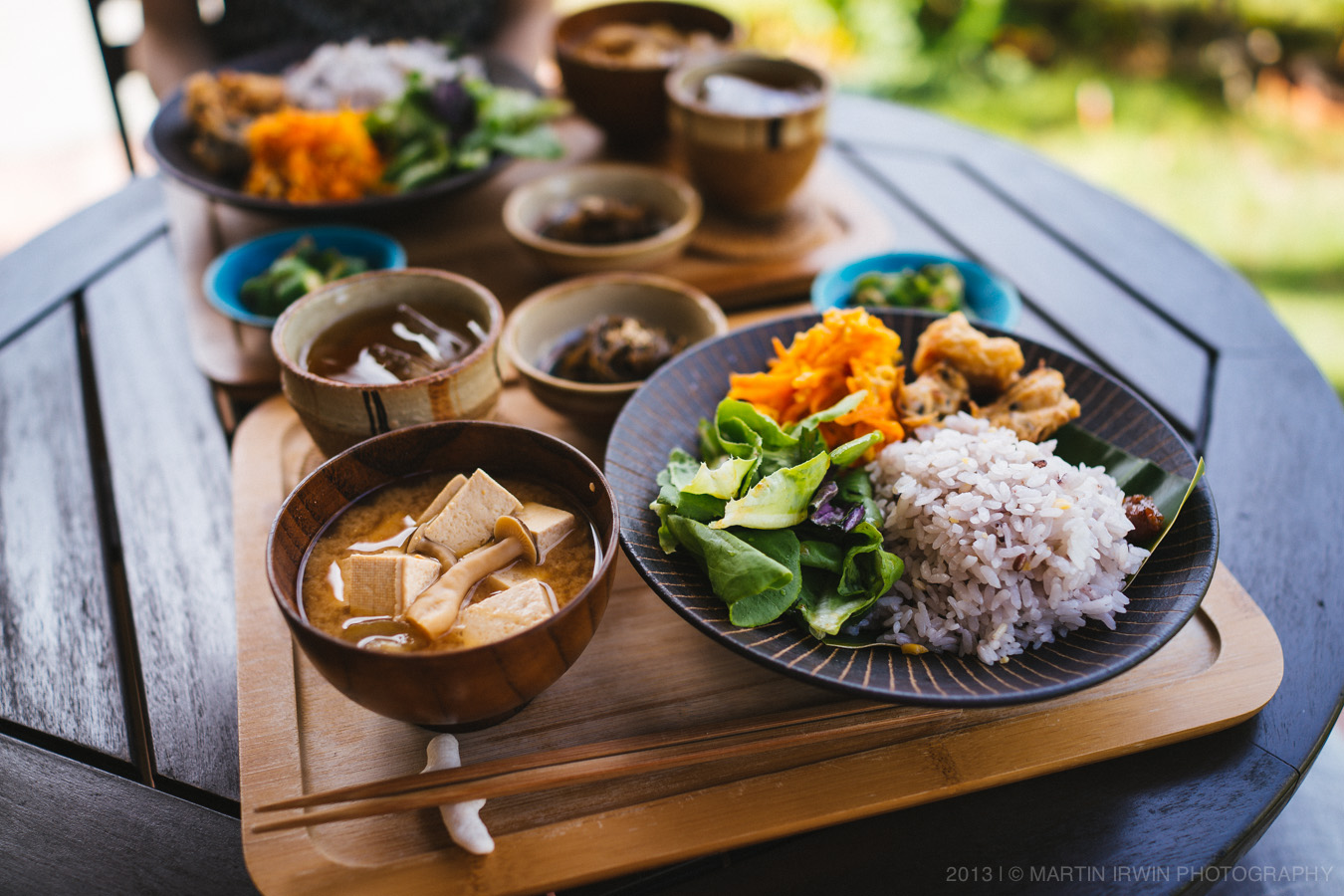
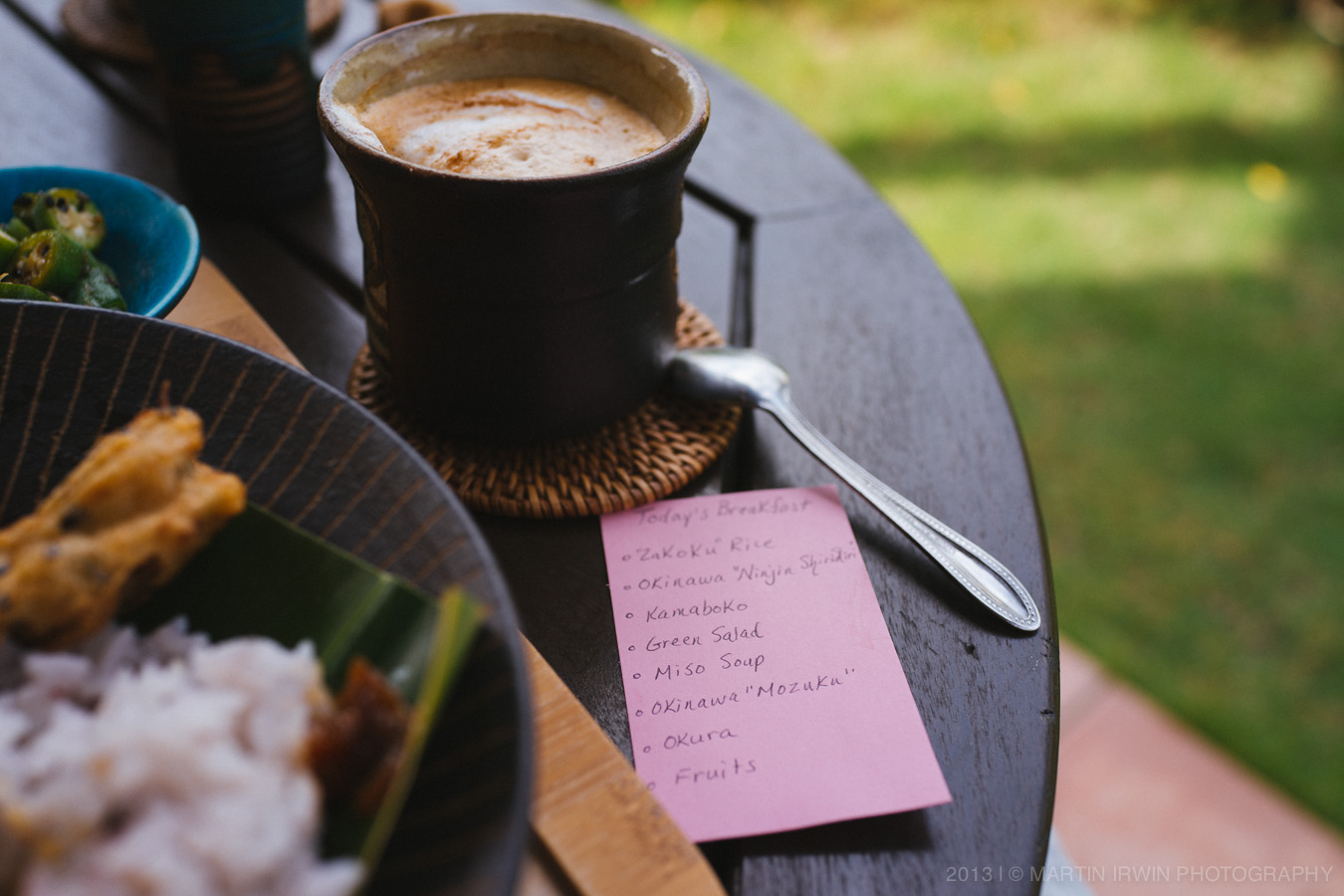
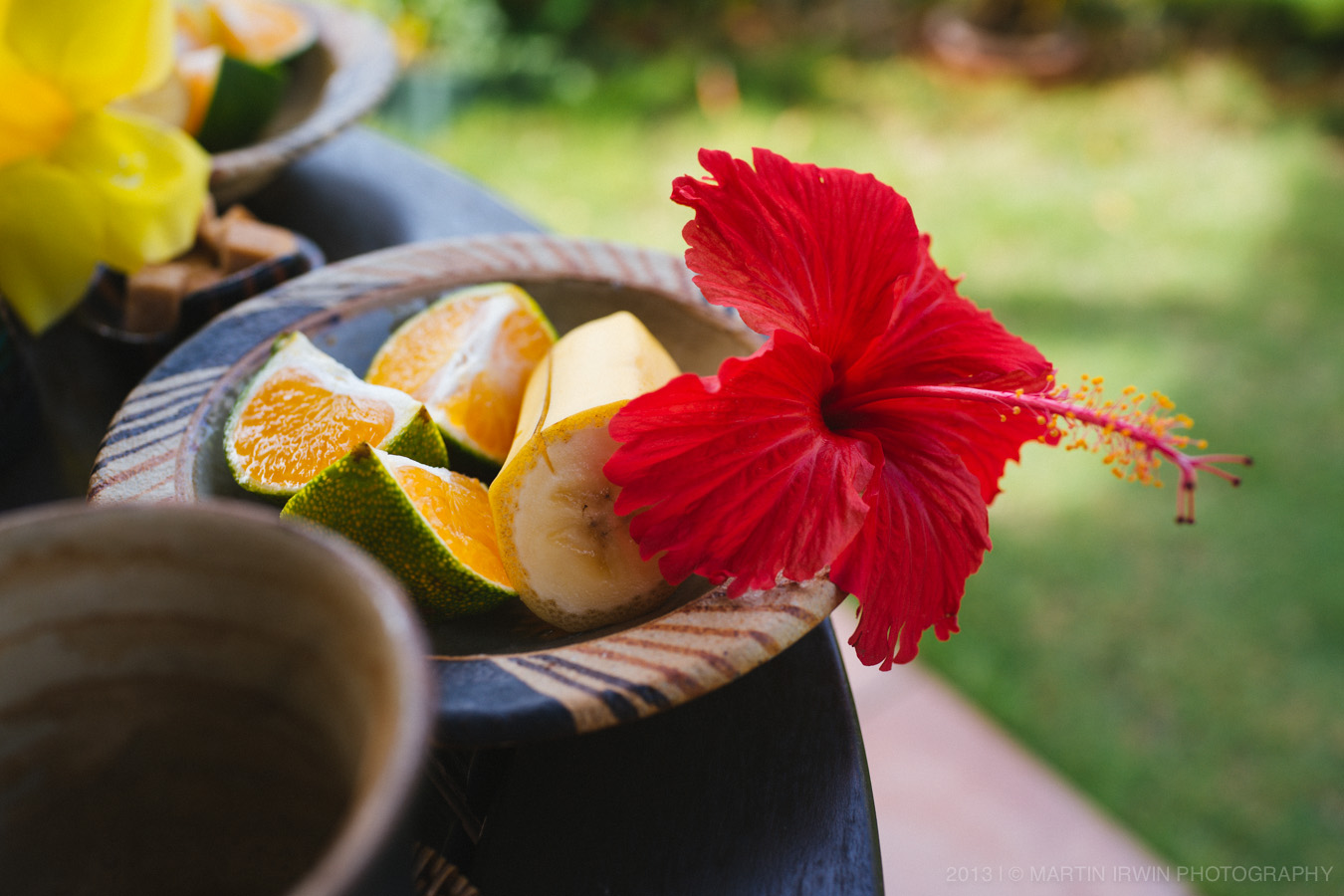
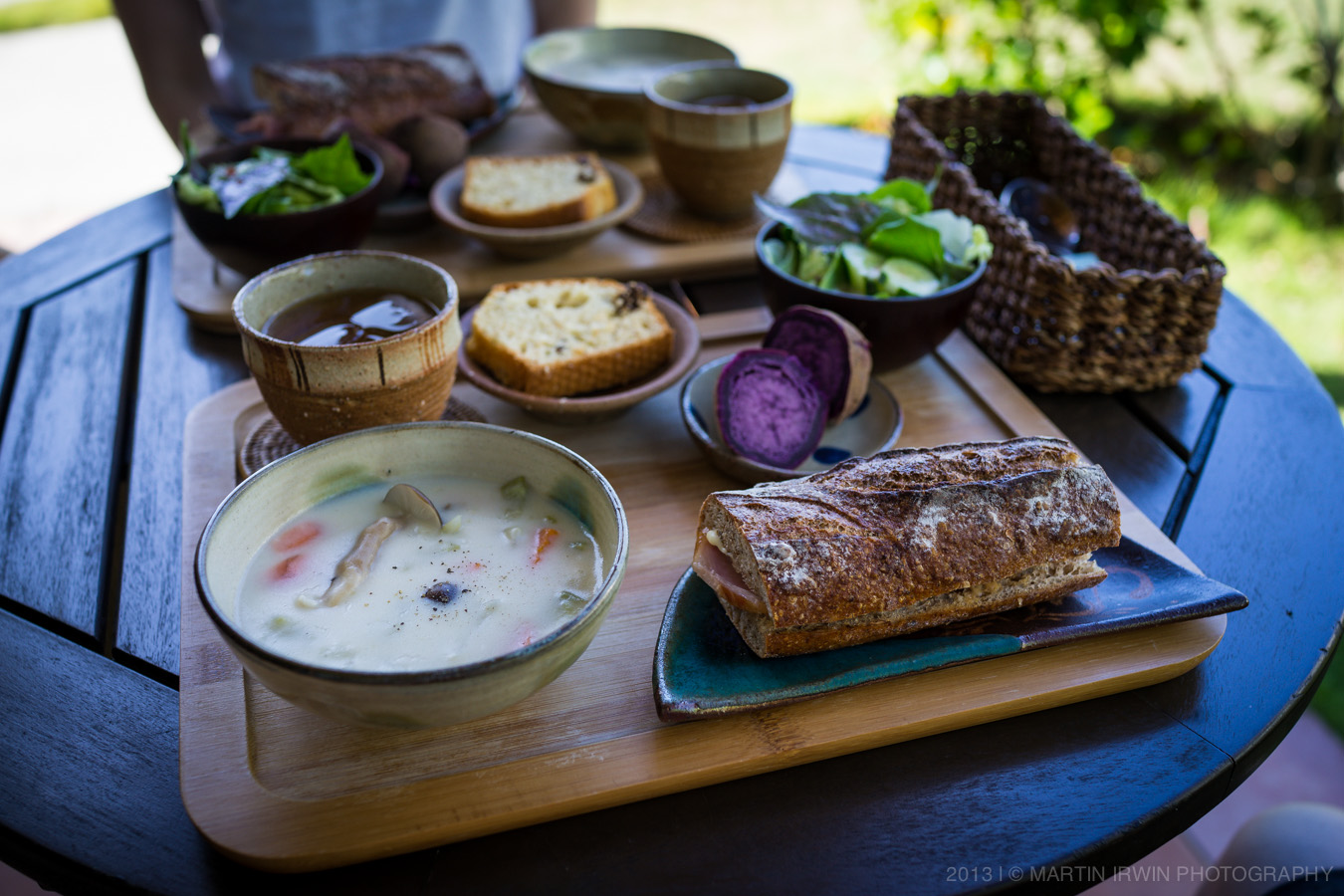
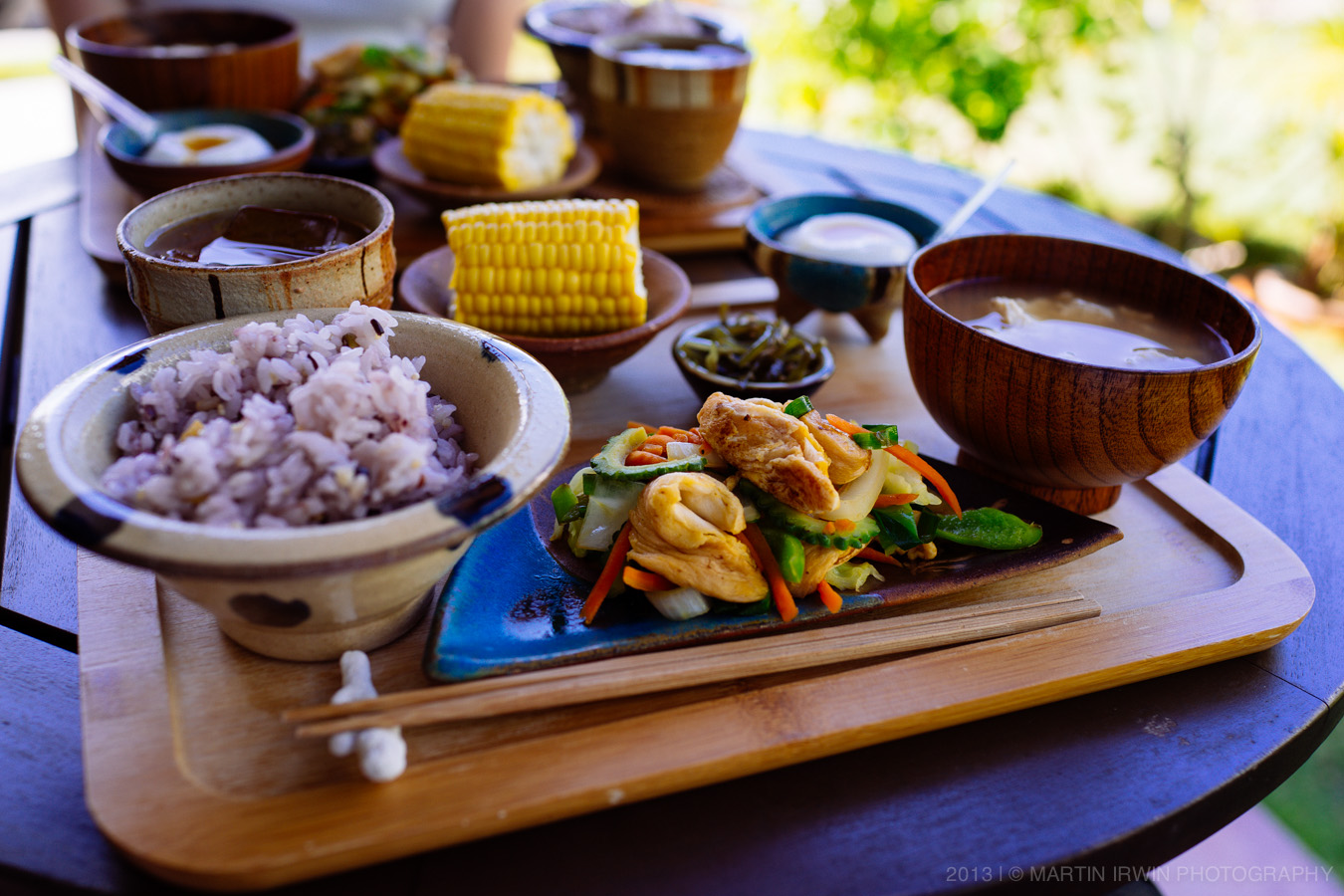
If you stay in a business hotel during your time in Japan, don't get your hopes up regarding breakfast. It'll probably be OK. At Akachichi, we were treated to a home-made feast each morning! The care and attention, variation, and presentation were fantastic. So many people take their camera out before they start a meal that it's almost become the new Grace. I simply could not resist, every morning. When looking through the photos of breakfast, we tried to decide which was our favourite... but there is no winner. Well, there is no loser. They were all fantastic, and were a great start to the day. That and the two-cappuccino habit we started.
What are you looking at?
The beaches at Cape Maeda are characterised by the beautiful coral reef, and the humans inhabiting it. OK, that's a slight exaggeration. The humans are only visible during the day. If you scroll back up to the beach photo, you may notice a tour group or two, in the sea near the rocks. The area is packed full of fish and marine life, and snorkelling tours make a killing by taking groups of Japanese around and showing them the locations of the most interesting stuff. This worked out to be extremely useful for us, as we could very efficiently locate clown fish, anemones, and hundreds of other species by shrewdly waiting until the group left the area. This [arguably] made for a much more enjoyable experience than in a snorkel tour group, where the number of people outnumber the fish 3:1. One day I'll buy a waterproof camera housing. Until then, it's land-only I'm afraid.
We spent a few days on the beach, exploring the area around Maeda-point, and the nearby pottery village of Yomitan. All-in-all, we had a very relaxing few days. On our final day, we went for a bit of a drive northwards, to sesoko island (location of the above photo). We didn't go on any hiking tours, banana-boat rides, excursions, organised sight-seeing... just chilled out on various beaches and ate copious amounts of Blue Seal ice cream. We were replenishing our energy, and saving it for the next leg of our journey.
To be continued...
Akachichi is conveniently placed for exploration of Okinawa Honto. Kenny and Komaki have excellent knowledge of the island, as well as running a top-notch guesthouse. I'd recommend staying there if visiting Okinawa. If you do visit, please send my regards!
Typhoon visit
Typhoon visit │ NEX-7 & SEL18200LE │ 95mm, ISO 100, f/6.3, 1/25, RAW
In the past 5 days, I have covered over 4000 km, by plane and car. I've travelled from Tokyo to Naha, to Cape Hedo in the Northern tip of Okinawa's main island. Usually, I would say it's been a whirlwind visit, but being as the rainy season is on its way, and I am in Japan, typhoon should do the trick.
When my co-worker and I arrived in Okinawa, it was raining. Hard. We hopped into the hire car and made our way up Route 58 from Naha, which goes all the way up the west of the island, to Cape Hedo. We stopped on the way to have a delicious, local lunch with a couple of my colleagues old friends. Our mission was to replace some parts of an instrument there, amongst other things.
As expected, things didn't go smoothly. We discovered that the main UPS system had failed, meaning our data had no sure-fire time stamps. Damn. However, we were in luck! By complete co-incidence, I also had to change the UPS battery in another system, so we had a spare on site. The old battery still worked well, and we did a "bodge-job", so we can at least resume measurements for now. The nearest hardware store is over 1 hour's drive away (one-way). This means we have to be as prepared as we can be, each time we leave that shop.
One of the issues with Okinawa, is its excessive year-long heat, humidity, and salty air. This corrodes most objects, turning them to rust within a few days, or weeks. This voltage transformer, for example, was actually in a plastic box, but still managed to age several years within just one.
After repairing all of the instruments, we finally have a stable system in place, and we're learning what else we need to prepare for, with each coming visit. I usually like to take a lot of photos when I visit places, but we worked from sunrise to gone-sunset, leaving no time for anything other than driving, eating, and sleeping.
So for now, so long, Okinawa! I hope to see you soon.
